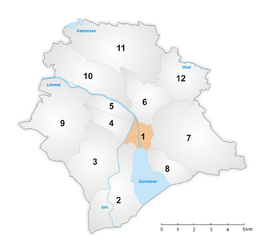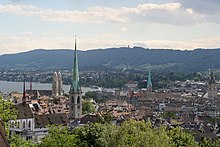Old Town (City of Zurich)
|
Old town district of Zurich |
|
|---|---|
| Coordinates | 683 312 / 247189 |
| surface | 1.80 km² |
| Residents | 5750 (December 31, 2018) |
| Population density | 3194 inhabitants / km² |
| structure | |
| circle | 1 |
| Quarters | |
Altstadt is an urban district of the city of Zurich in Switzerland .
The old town covers the area of the original city of Zurich , which existed until 1893, and forms today's District 1 . Historically, the old town is divided into the Small or Minor Town on the left of the Limmat, and the Large or Multiple Town , today imprecisely called Dörfli or Niederdorf.
Administratively, the old town has been divided by the statistical office since 1971 into the four administrative units (quarters) town hall and universities ( right of the Limmat ), as well as Lindenhof and City ( left of the Limmat ); this classification is only of statistical significance.
Attractions
See also: List of cultural assets in Zurich / District 1 (East) , List of cultural assets in Zurich / District 1 (West)
On the right the Limmat
- One of the special sights of Zurich's old town is the Niederdorf on the right bank with its numerous shops and restaurants.
- The Zurich City Hall , originally built on an island in the Limmat, belongs to the Canton of Zurich . The canton council meets here on Mondays and the municipal council (legislature) on Wednesdays.
- The keys to the city gates were kept overnight in the main guard house. Since the gates were closed when sleeping, the key had to be brought here through the dark alleys. For this reason, the city's first street lamp was erected in front of the town hall guard.
- The house in which Lenin lived during his stay in Zurich is at Spiegelgasse 14 .
- In front of the guild houses, the road ran under the Tilinen (arches) until the 19th century ; the houses stood directly on the Limmat. Today's Limmatquai was later filled up.
- The coat of arms shows the medieval Grendeltor, which was built as part of the city fortifications in 1445 and demolished in 1836. In 1977 the neighborhood association presented three proposals for a neighborhood coat of arms in the neighborhood newspaper. The motif "Grendeltor" by Ernst Sigrist was chosen . In the "official" version, the gate opening is white and not blue. This gives the impression that the gate is closed. In contrast to the “normal” city gates, there were no gate wings, but a locking beam was lowered on chains, which prevented the ships from passing.
Rathausbrücke : The old main guard at the town hall.
Left the Limmat
- In front of the Fraumünster there is a statue of the former mayor Hans Waldmann on the site of the former granary . His tomb is a few steps away in the Fraumünster to the left of the entrance.
- The Schipfe is one of the oldest quarters in Zurich. The name comes from the sailors that here their Weidlinge shore and back into the water "schupften" (= extended).
- In front of the town house , the arches in the former sea wall can still be seen, through which the barges could get directly into the cellar of the granary above.
- The Zunfthaus zur Meisen housed Zurich's first observatory in 1759.
View of the Schipfe from the Rudolf-Brun-Bridge
Churches
Churches in Zurich's old town:
- Grossmünster , a former Augustinian - Chorherrenstift over the graves of the city saints Felix and Regula built and location of the first secondary school, which according to legend was founded by Charlemagne. His statue stands on the southern tower, the so-called Karlsturm. The Grossmünster was the starting point for the Zurich Reformation by Zwingli and Bullinger .
- Fraumünster , a former women's monastery , whose founding history is depicted on frescoes in the cloister. His political influence in the Middle Ages was so great that his abbess was also called the city's unofficial princess.
- St. Peter was the city church. The tower belongs to the city and was inhabited by a night watchman until 1911. The dial is the largest in Europe.
- The preacher's church belonged to the Dominican monastery, which included the entire preacher's quarter. The actual monastery became a hospital and poor house and burned down at the end of the 19th century. In its place is now the Zurich Central Library .
- The Wasserkirche was built on an island in the Limmat at the place of execution of the city saints Felix and Regula.
Other churches and synagogues in district 1 (old town)
In addition to the churches described above, there are other churches in City District 1:
- The station church is a prayer room in Zurich main station , which was inaugurated on Pentecost Sunday 2001 as the first station church in Switzerland that still exists today. The chapel, a reception room and two meeting rooms are located on 60 square meters. The church is visited by around 300 to 500 people (as of 2012) every day. In this church people of all religions and denominations are welcome, as the signs of the five world religions in the church also refer to.
- The Grossmünster Chapel was built in the years 1858–1859 according to plans by the architect Johann Jakob Breitinger (1814–1880). In the Middle Ages the wooden house Müsegg stood here , but it was demolished in 1661. The Grossmünster Chapel is a polygonal corner building in Tudor Gothic , which was built together with the fountain next to it. The lead-glazed windows from the years 1858–1860 were made by Johann Jakob Röttinger .
- The Friedenskirche is a church built in 1890 by the master builder Johannes Baur, which stands on Hirschengraben. The neo-Gothic building reveals itself as a church with its high ridge turret, which is rather rare for churches of free church communities. The Friedenskirche initially belonged to the Evangelical Community , which was founded around 1800 by the preacher Jakob Albrecht as a German-speaking church community in the USA. In 1988 the Movement Plus Zurich took over the Friedenskirche, which has been a listed building since 1993.
- The Church of Saint Andrew's is the church of the Anglican Church Fellowship in Zurich and is located on Promenadengasse. It was built between 1847 and 1848 according to plans by (Caspar) Ferdinand Stadler as a cemetery chapel for the Hohe Promenade cemetery . In 1895 the sacristy and choir of the church were added. 1972–1974 the rectory was added to the church.
- The Taborkapelle is on Promenadengasse and is a neo-Gothic prayer room with an organ gallery that belongs to the United Methodist Church. The church was built in 1873 according to plans by Johannes Baur and its name is reminiscent of Mount Tabor , on which, according to Christian tradition, the Transfiguration of Jesus took place.
- The Eglise réformée française zurichoise stands at the corner of Schanzengasse and Promenadengasse and was built between 1900–1902 according to plans by the architect Benjamin Recordon . This church is owned by the Reformed Church and used by the French-speaking community.
- The Augustinian Church was built by the Augustinians in 1270 . In the course of the Reformation , the Augustinian monastery was dissolved in 1524. A mint was operated in the Augustinian Church between 1596 and 1841 . In 1840 the church was given to the Catholic parish of Zurich and, after the church split between the Roman Catholic Church and the Christian Catholic Church, the latter was handed over. In 1900 the church received five bells and has been a listed building since 1958.
- The St. Anne's Chapel was built between 1909-1911, designed by Robert Bischoff and Hermann Weideli in Heimatstil built. The previous building was the parish church of the Catholic Church in Zurich from 1807 to 1844, until the church became too small and the parish moved to the church of the former Augustinian monastery. The St. Anna Chapel is run by the St. Anna Congregation, which is a branch of the Foundation of Protestant Societies of the Canton of Zurich. The St. Anna Chapel has not been a parish church since 1937.
There are also two synagogues in District 1 :
- The Löwenstrasse synagogue was built between 1883 and 1884 according to plans by the architects Alfred Chiodera and Theophil Tschudy in an orientalizing, Moorish style. It is operated by the Israelitische Cultusgemeinde Zurich .
- The Freilutstrasse synagogue is operated by the Israelite Religious Community of Zurich and was built between 1923 and 1924 according to plans by the architects Walter Henauer and Ernst Witschi .
literature
- Local history of the city of Zurich . Office material management, Zurich 1977.
- Christine Barraud Wiener, Petre Jetzler: The art monuments of the canton of Zurich, Volume I: The city of Zurich I. City in front of the wall, medieval fortifications and Limmatraum. (= Art Monuments of Switzerland. Volume 94). Edited by the Society for Swiss Art History GSK. Bern 1999, ISBN 3-909164-70-6 .
- Regine Abegg, Christine Barraud Wiener: The Art Monuments of the Canton of Zurich, Volume II.I: The City of Zurich II.I. Old town to the left of the Limmat, sacred buildings. (= Art Monuments of Switzerland. Volume 99). Edited by the Society for Swiss Art History GSK. Bern 2002, ISBN 3-906131-03-3 .
- Regine Abegg, Christine Barraud Wiener: The Art Monuments of the Canton of Zurich, Volume II.II: The City of Zurich II.II. Old town on the left of the Limmat, secular buildings. (= Art Monuments of Switzerland. Volume 102). Edited by the Society for Swiss Art History GSK. Bern 2003, ISBN 3-906131-77-7 .
- Karl Grunder: The Art Monuments of the Canton of Zurich, Volume IV: The City of Zurich IV. The entrenchments and the baroque suburbs. (= Art Monuments of Switzerland. Volume 105). Edited by the Society for Swiss Art History GSK. Bern 2005, ISBN 3-906131-81-5 .
- Regine Abegg, Christine Barraud Wiener, Karl Grunder: The Art Monuments of the Canton of Zurich, Volume III.I: The City of Zurich III.I. Old town on the right of the Limmat, sacred buildings. (= Art Monuments of Switzerland. Volume 110). Edited by the Society for Swiss Art History GSK. Bern 2007, ISBN 978-3-906131-86-3 .
- Christine Barraud Wiener, Cornelia Stäheli, Karl Grunder, Regine Abegg: The Art Monuments of the Canton of Zurich, Volume III.II: The City of Zurich III.II. Old town on the right of the Limmat, secular buildings. (= Art Monuments of Switzerland. Volume 111). Edited by the Society for Swiss Art History GSK. Bern 2007, ISBN 978-3-906131-87-0 .
- Christine Barraud Wiener, Regula Crottet, Karl Grunder, Verena Rothenbühler: The Art Monuments of the Canton of Zurich, New Edition Volume V. City of Zurich V. (= Art Monuments of Switzerland. Volume 121). Edited by the Society for Swiss Art History GSK. Bern 2012, ISBN 978-3-03797-030-0 .
- Building Construction Department of the City of Zurich, Office for Urban Development: City Center - Old Town / City. Building Culture in Zurich, Volume VI. Verlag Neue Zürcher Zeitung , Zurich 2008, ISBN 978-3-03823-343-5 .
Web links
Individual evidence
- ↑ Lindenhof district review (PDF; 14.7 MB) , Lindenhof in der Minderen Stadt
- ↑ See the following: Robert Schönbächler: Churches and places of worship in the city of Zurich. New Year's Gazette Industriequartier / Aussersihl. Zurich 2013, pp. 25–45.
















